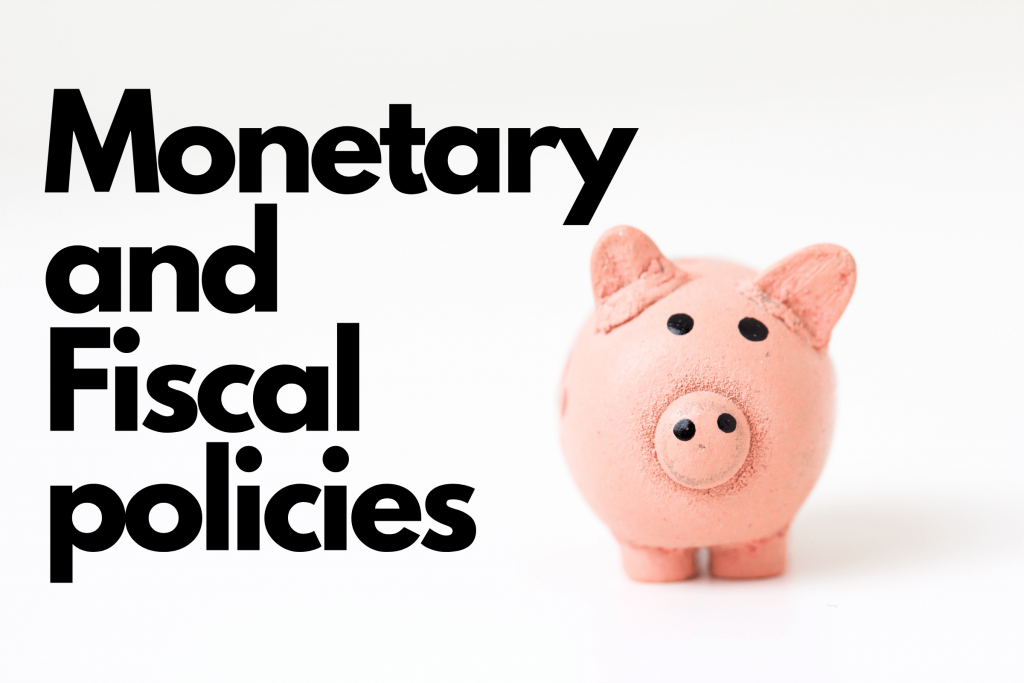
Introduction
Monetary and fiscal policies are two essential tools that governments use to manage the economy. Monetary policy refers to the actions taken by a central bank, such as the Federal Reserve in the United States, to influence the supply and demand of money in the economy. This can be done through various means, such as adjusting interest rates or buying and selling government securities. On the other hand, fiscal policy involves the government’s spending and taxation powers to influence economic activity. The government can control aggregate demand and economic activity by adjusting government spending and taxation level. Together, these two policies can achieve various financial objectives, such as stabilizing prices, boosting employment, and promoting economic growth.
Monetary Policy
Monetary policy is the actions a central bank takes to influence the supply and demand of money in the economy, aiming to achieve a range of macroeconomic objectives. The main goals of monetary policy are generally to maintain price stability, maximize employment, and support economic growth.
To achieve these goals, central banks use various tools to influence the economy’s money supply and interest rates. The most commonly used tool is the setting of the federal funds rate, which is the interest rate at which banks lend money to each other overnight. By raising or lowering the federal funds rate, the central bank can influence different interest rates in the economy, which can affect consumer and business borrowing and spending decisions.
Another crucial monetary policy tool is open market operations, which involve the central bank buying and selling government securities in the open market. By buying securities, the central bank can inject money into the economy and lower interest rates, while selling securities has the opposite effect. Central banks may also use other tools, such as reserve requirements and discount window lending, to influence the economy’s money supply and interest rates.
The federal funds rate is the interest rate at which banks lend money to each other overnight, and it is one of the main tools used by the central bank to implement monetary policy. By raising or lowering the federal funds rate, the central bank can influence other economic interest rates and affect borrowing and spending decisions. The federal funds rate is typically changed in response to changes in the economic outlook, which is a critical factor in determining the overall level of interest rates in the economy.
Fiscal Policy
Fiscal policy refers to using government spending and taxation to influence economic activity. The main goals of fiscal policy are to stabilize the economy, promote economic growth, and reduce income inequality.
Fiscal policy can be either expansionary or contractionary, depending on whether it is designed to stimulate or dampen economic activity. Expansionary fiscal policy involves increasing government spending or reducing taxes to boost demand and stimulate economic growth. This can be done, for example, by increasing infrastructure spending or providing tax cuts to individuals and businesses. On the other hand, contractionary fiscal policy involves reducing government spending or raising taxes to slow down the economy and control inflation.
One potential downside of expansionary fiscal policy is the crowding out effect, which occurs when increased government borrowing crowds out private investment. This can happen when the government increases its borrowing to finance increased spending. The resulting increase in demand for credit drives up interest rates, making it more expensive for businesses and households to borrow money for investment. As a result, private investment may decrease, offsetting some of the intended stimuli from the government’s increased spending.
Overall, fiscal policy is a powerful tool that governments can use to manage the economy and achieve various economic objectives. However, it is essential for policymakers to carefully consider the potential trade-offs and risks associated with different fiscal policy choices.
Monetary and Fiscal Policy Compared
Monetary and fiscal policies are two essential tools that governments use to manage the economy. While both policies can achieve similar goals, such as stabilizing prices and promoting economic growth, there are some critical differences between the two.
One of the main differences between the monetary and fiscal policy is who is responsible for implementing the policy. Monetary policy is implemented by the central bank, while the government implements budgetary procedures through its spending and taxation powers. This means that the central bank has more independence in setting monetary policy, while fiscal policy is more subject to political considerations and the influence of special interest groups.
Another critical difference between the two policies is the tools they use to achieve their objectives. Monetary policy primarily uses interest rates as its primary tool, while fiscal policy uses government spending and taxation. Because interest rates affect the cost of borrowing and the return on saving, changes in monetary policy can directly and immediately impact the economy. In contrast, changes in fiscal policy, such as increased government spending or tax cuts, can take longer to affect the economy and may be less predictable in their impact.
While monetary and fiscal policies play essential roles in managing the economy, they have different strengths and weaknesses and may be used in different ways to achieve other objectives.
Quantitative Theory of Money
The quantitative theory of money is an economic theory that states that change in the money supply are the primary cause of changes in the price level. This theory is based on the idea that a difference in the money supply will lead to a proportional change in the price level. Central banks use this theory to help them determine the appropriate level of the money supply to achieve their goals.
Unit of Account
A unit of account is an economic unit used to measure the value of goods, services, and financial assets. The most common team of history is the national currency, such as the U.S. dollar. Other branches of account include gold and other commodities. Central banks use units of charge to help them determine the appropriate level of the money supply to achieve their goals.
Taylor Rule
The Taylor Rule is an economic rule proposed by economist John Taylor which suggests that the Federal Reserve should adjust the federal funds rate in response to changes in the inflation rate and the output gap. The output gap is the difference between the actual output of the economy and the potential output of the economy. The Federal Reserve uses the Taylor Rule to help determine the appropriate interest rate level to achieve its goals.
Monetary Base
The monetary base is the total amount of money in an economy. It is composed of currency in circulation, deposits held by commercial banks at the Federal Reserve, and other items such as Treasury securities. The Federal Reserve uses the monetary base to determine the appropriate level of the money supply to achieve its goals.
Tight Money Policy
A tight money policy is a policy of keeping the money supply at a low level. This policy is used to slow down the economy when it is growing too quickly or is inflationary. A tight money policy can be achieved by increasing interest rates, reducing government spending, or raising taxes.
Learn more about laws
Conclusion
Monetary and fiscal policies are two main tools governments and central banks use to manage the economy. Monetary policy uses interest rates, reserve requirements, and the money supply to influence the economy. In contrast, fiscal policy uses government spending and taxation to control the economy. Understanding the differences between these two policies is essential for making informed economic decisions. The quantitative theory of money, the unit of account, the Taylor Rule, the monetary base, and the tight money policy are all essential concepts in understanding how monetary and fiscal policies affect the economy.
Recent Questions
What is fiscal policy?
Fiscal policy refers to using government spending and taxation to influence economic activity.
What is the federal funds rate?
The federal funds rate is the interest rate at which banks lend money to each other overnight.
The four main tools of monetary policy are?
The four main monetary policy tools are setting the federal funds rate, open market operations, reserve requirements, and discount window lending.
Complete sentence financial markets pay close attention to changes in the federal funds rate because these changes
Financial markets pay close attention to changes in the federal funds rate because these changes can impact borrowing and spending decisions.
A lower interest rate increases consumption, investment, and _____, which _____ aggregate demand.
A lower interest rate increases consumption, investment, and net exports, which boosts aggregate demand.
To decrease the money supply using the reserve requirements, what would the fed typically do?
The Federal Reserve would typically raise the required reserve ratio to decrease the money supply using the reserve requirements.
What is expansionary monetary policy?
Expansionary monetary policy is a type of monetary policy that aims to stimulate economic growth by increasing the money supply and lowering interest rates.
What would be a way for the federal reserve to slow down the economy when it is growing too quickly or is inflationary?
A way for the Federal Reserve to slow down the economy when it is growing too quickly or is inflationary is to raise the federal funds rate or sell government securities to reduce the money supply.
A goal of monetary policy and fiscal policy is to?
A monetary and fiscal policy goal is to stabilize the economy, promote economic growth, and reduce income inequality.
Monetary policy is determined by?
The central bank, such as the Federal Reserve in the United States, determines monetary policy.
Complete sentence An increase in the money supply will
An increase in the money supply will lead to lower interest rates and increased borrowing and spending.
Contractionary fiscal policy is so named because?
Contractionary fiscal policy is so named because it involves reducing government spending or increasing taxes to slow down the economy.
A monetary rule would make it difficult to?
A monetary rule would make it challenging to use discretionary policy to respond to changing economic conditions.
What would be a way for the federal reserve to stimulate a sluggish economy?
A way for the Federal Reserve to stimulate a sluggish economy is to lower the federal funds rate or buy government securities to increase the money supply and reduce interest rates.


